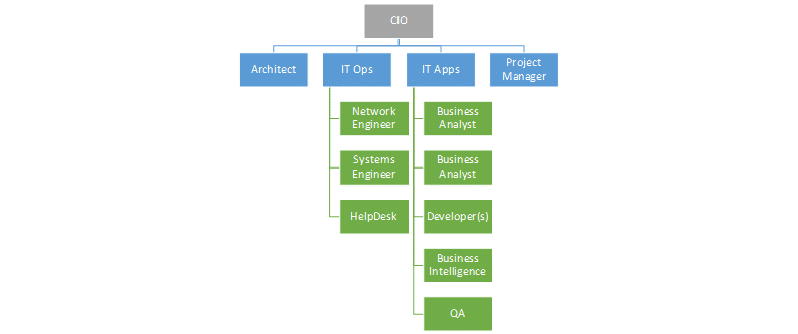What Your IT Team Should Look Like
I'm sure you've seen the headline somewhere over the past few years "Every Company is a Technology Company" or something very similar. I am certainly a believer. There can be lots of things within your business that don't require technology but if you're not taking advantage of technology, you're not going to be as successful as you could be, no matter what business you're in.
If every company is a technology company, every company should have someone who works with technology. That seems like a logical argument, right? If that's true, your question may be, "what should your IT team look like?" I've worked with many, many different IT structures over my years in the technology world and I believe IT team structures are like snowflakes, no two are the same. I am happy to say that the teams have evolved over the past few years but they haven't evolved enough yet to the structure I think is most successful. Here is my blueprint for an IT team of a 1000 person business (you can scale this up or down to fit your business. I've also written a follow-up article on how to manage technology at a small business - less than 50 people). This plan assumes that you are spending an average amount of around 4-6% of your annual revenue on technology.
First, it starts at the top. If you believe your company is a technology company, you need to have an executive who is responsible for technology. I've started to see more companies utilize a CITO role, which combines the CIO and CTO role, but I don't care as much what you call it as long as you have an executive who is responsible for your overall technology vision and who runs your IT team. I've seen this change for the better recently; even 5 years ago most companies had IT report up through Finance (CFO) with the thought that IT is a necessary expense that needs to be controlled and limited as much as possible. The modern approach of having a technology executive allows him or her to give insight into everything you do in the business and to think about how technology can help in many facets of the business. If an investment in technology can help you provide better customer service, your technology executive can make that suggestion and work to make that system a reality for your team.
It is really naïve when a company hires an IT person and assumes that they will know everything IT related. IT is extremely complex and someone who knows hardware is unlikely to be an expert in ERP systems, project management, and cloud HR applications. The modern IT team is going to need different disciplines and it's going to need the services of outside experts. I suggest hiring well-rounded IT people and outsourcing the specific expertise to vendors who specialize in that area. Any IT budget should be a mix of internal resources and external experts.
With the right leader and representation on the leadership team, the IT team should be organized in the most effective way to support a cloud-first technology world. In the past, most of the IT team was working on networks and servers, generally known as IT Operations. You're still going to need an IT Operations resource or two, but you aren't going to need an army like you used to have. For the IT Operations side of the business, you should have a network person, a hardware person and your HelpDesk resources sitting in that group. You could have a security person sitting in that world too, but security can be very complex and I'd recommend outsourcing periodic security assessments to outside experts.
The most overlooked role in modern IT teams is the role of the business analyst or product owner (I'll call it business analyst from here on out). The role of the business analyst is to understand the business deeply and work to provide technology solutions that help the business be more efficient and effective. Companies should have a business analyst focused on the core part of the business (like manufacturing if that's what you do) and one (or two) focused on the supporting teams like sales, customer service, and accounting. The business analyst should sit in on those department's leadership meetings so they know what they need at all times. They should report back to the IT team and leadership what the priorities are and come with ideas on how to achieve them. Once they are working on a project for their team, they should gather requirements, evaluate solutions and work to help implement those solutions for their team. This focus on the business allows the organization to get the tools that really fit the needs of their employees leading to greater efficiency and higher customer satisfaction.
A role seen even less frequently than the business analyst is the role of an architect. Not every company has to have an architect if the technology leader can fill that gap, but I strongly recommend investing in a technologist who can make sure all your systems work together effectively. I've seen many companies where data is duplicated or mastered in multiple different systems which don't talk to each other. The architect's role is to focus on integration - try to make all your systems talk together (integrate your ERP and CRM systems) and that every piece of data has a master system. Systems developed in silos can give you good best-of-breed tools but it creates a big mess if you're trying to get a 360-degree view of your customers and employees. Hire an architect and give him or her the authority to make decisions on what systems are used and how they all come together.
Another uncommon role in today's IT organizations is the role of a project manager. With multiple projects going on all the time in an IT organization, you need a symphony conductor to keep your team one the same sheet of music. If you haven't already, you should learn everything you can about agile methodology and how to manage backlogs. Your IT team should always have a backlog of tasks and you need a project manager to manage that backlog. Many IT leaders think they are in charge, so they should do that, but they could make better use of their time providing technology options to the business rather than the blocking and tackling of assigning tasks and checking in on progress. A modern IT team needs at least one PM to manage any internal work as well as managing the vendor staff.
If you're going to develop on top of your core platforms or especially if you're developing custom software, you'll need developers - you don't have to have developers because you can certainly outsource that function, but it will be cheaper if you can do it in-house. I generally recommend large enterprises have a developer or two who can learn the core applications well enough to do basic customizations. You would use your software providers to do the heavy lifting but it's certainly cheaper to do the development in house.
If you have developers, you may want to have quality assurance (QA) staff. That's a great place to start someone or to use a company like mindShift which provides work opportunities for people with autism. Your QA staff should be proportional to your developers - you should think about one QA person for every two developers.
You are going to need a resource with skills in the Business Intelligence realm - that could potentially be one of your business analysts or a developer, but if you don't have that covered, you should have someone who can build the reporting your team needs to extract the value from these systems. I am a big believer in a weekly leadership scorecard which pulls the key metrics for your team into a one-page dashboard they can read and react to quickly. If you have a data warehouse, your BI resource can build something like that quickly and build department-level scorecards as well.
Here's a view of how that might be structured:
I'll just touch on a few systems or approaches and can dive into that at a later time - you'll need to have a HelpDesk system with service level agreements with your business as well as a DevOps system where you manage your product backlog and report on progress to your business departments (your customers).
Every company is different but in today's cloud-first world, you need a responsive IT organization that is tightly integrated with the rest of the business.
Under the terms of this license, you are authorized to share and redistribute the content across various mediums, subject to adherence to the specified conditions: you must provide proper attribution to Stoneridge as the original creator in a manner that does not imply their endorsement of your use, the material is to be utilized solely for non-commercial purposes, and alterations, modifications, or derivative works based on the original material are strictly prohibited.
Responsibility rests with the licensee to ensure that their use of the material does not violate any other rights.






